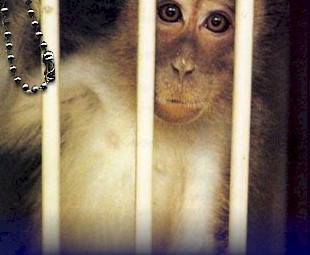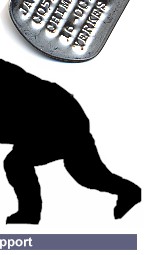Rhesus
monkeys are the most widely used monkeys in biomedical and behavioral
research in the U.S. today and probably throughout the world. It
is generally agreed that at least one million rhesus monkeys were
consumed in U.S. laboratories in the 1950’s and 60’s during
the polio vaccine search, and some estimates run as high as five
million. Worldwide, the demand stripped India of nearly its entire
rhesus population from an estimated high, prior to the export rush,
of ten million monkeys down to an estimated 200,000 when India banned
export of the animals.
Rhesus popularity in research labs has remained high; not, as the
primate labs are wont to claim, because they are productive models
of human illness – they aren’t, but rather because these
animals breed readily in captive situations and are easy to keep
alive for extended periods. They are very tough.
r95100 was born
on October 21, 1995 at the Wisconsin Regional Primate Research Center
(WRPRC). His mother was r89114 and his father was r84107.
Monkeys at WRPRC are designated with serial numbers that tell something
about the animal. r95100 was the 100th
rhesus monkey born at WRPRC in 1995. His mother was the 114th
rhesus born there in 1985 and his father the 107th
rhesus monkey born there in 1984. WRPRC has about 1200 monkeys (mostly
rhesus monkeys) on hand at any one time. The population is stable
which means that many are dying every year.
r95100 weighed 0.510 kilograms when he was born. That’s about
one pound.
He was first used for research on January 19, 1996, when he was
less than three months old. Blood was taken.
He gained weight steadily, and on June 20, 1996, he was up to 1.390
kilograms.
On June 30, his weight dropped to 1.1 kilogram and was reported
to have diarrhea.
They began treating him with the antibiotic erythromycin, but the
diarrhea continued and he failed to gain weight. On August 21 he
still weighed 1.1 kilogram.
The erythromycin was continued daily, and on August 26, his weight
had inched up to 1.16 kilos.
On September 4, he was still receiving the erythromycin twice daily.
His weight had continued to inch up and he now weighed 1.17 kilos.
His medical history notes that he had a “history of vomiting
white material – possibly milk.” The record notes: “loose
stool, light brown in color. well (sic) wean from milk.” He
was given a multivitamin and later that day noticed to have “yellow
loose stool.”
The erythromycin was stopped on September 5. Still on September
9, the record notes that they took a bit more of his blood and that
his weight was now 1.55 kilograms.
On November 11, his weight is recorded to be 1.81 kilos.
On the following day, he is anesthetized with 30 mg. of Ketamine
delivered intravenously, and tattooed with his serial number.
On December 9, he weighs 1.98 kilos.
On January 9, he is up to 2.3 kilos.
On March 11, 14cc of blood was taken for the project: “Immunobiology
of SIV Infection.”
On March 31 he weighed 2.49 kilograms.
On April 24 he had another 14 cc drawn, this time for the project
: “Immunobiology of SIV and SHIV.”
On May 15, another 14 cc for: “Immunobiology of SIV Infection.”
On May 21, he was treated for a prolapsed rectum. His colon was
sewn back in place with a purse string suture. A note from the same
day records: “trying to prolapse again.”
On May 22, the suture was removed and an ointment was applied to
his anus.
On May 23, it is noted that his rectum is trying to prolapse again.
He is treated with penicillin daily through May 27.
On May 28, 13 cc of blood is taken and again on May 29, another
7 cc is taken.
From May 29, to April 2, he is administered enrofloxacin daily.
And on April 2, the following remark appears: “ Removed purse
string suture from anus: animal is bright, alert, and responsive.
Eats well and has normal stools.” He is reported to weigh 2.23
kilos.
On July 8,more blood is taken, this time for WRPRC Director, Joe
Kemnitz’s project: “DNA Profiling of Primates Used in
Biomedical Research.”
It is worth noting here that Kemnitz has made spurious claims about
the importance of DNA profiles of monkeys in the past. In 1997,
a whistle blower provided documents from WRPRC that proved unequivocally
that WRPRC had been hiding the fact that they had secretly removed
over 200 monkeys from the zoo and sold them to labs throughout the
country as well as killed them in WRPRC’s own labs. This was
a direct violation of agreements WRPRC had signed with the local
county government that no monkeys from the zoo would ever be harmed
in biomedical research. When first contacted about one, then another
of these protected monkeys, Kemnitz made the claim that it was these
two monkeys’ “special genetic characteristics” that
allowed the Center to experiment on and kill them. When confronted
with the other 199 records, Kemnitz quickly changed his story. Further,
those familiar with the zoo monkeys noted that the large number
of males and females living together there made any claim of knowledge
regarding any of the offspring’s genetic characteristics laughable.
Throughout the remainder of 1997 and through 1998, r95100 had blood
drawn for one study or another eleven times and stomach fluid taken
once.
Every time blood was taken from r95100, he was immobilized with
Ketamine. Ketamine used to be used on humans; it’s not any
longer. Ketamine causes hallucinations as well as a burning sensation
when injected.
The principal effects are the result of the drug crossing the
blood brain barrier, to bind with receptors in the brain. Muscle
tone increases. Heart and pulse rate increase. The drug can cause
hallucinations, both visual and auditory. The user appears numbed
to the outside world. Awareness, although altered may only be partial.
Auditory perception is said to be narrowed. The ability to respond
may be limited by muscle spasm and rigidity. The user may appear
sedated, if not disturbed by the effects of the drug. Nausea and
vomiting may occur. Some degree of paralysis can occur. The effects
of the drug may be dependent on environmental factors.
Ketamine use is associated with flashbacks and other psychological
problems which become more frequent with long term use. Memory loss
and dysfunction are common. The development of psychotic illness
in vulnerable users is a real danger.
Ketamine can be a very unpleasant drug. It is contraindicated for
anyone with a medical history of heart disease, high blood pressure
and mental illness. [From: Drug by Drug http://www.drugtest.freeserve.co.uk/DbyDentry.htm]
The primate centers use gallons of Ketamine; whether it all ends
up in the monkeys is never discussed.
On February 5, 1999, r95100 was reported to have “self-inflicted
skin lesions.” This is a politically correct way to say that
the stress of lab life had become so great for r95100 that he had
begun chewing on, or scratching his own arms. The more accurate
term is “self-mutilation” and it is seen in very few other
environments. The primate labs tend to hush up this side of the
business.
Another note from February 5 states: “Closed with surgical
glue; lacerations on calf – possible self-biter; areas of over-grooming.”
“Over-grooming” is a nice way of saying that r95100 is
pulling out his own hair.
On April 13, 1999, we find the following remark: “Self trauma
– right and left arms – over biceps, muscles and under
left arm. Label cage ‘self biter’ and reduce room stress
or pre-treat with diazapam [Valium]”
According to WRPRC documents, on June
6, 2000, nearly five years old, r95100 was shipped to the University
of Baltimore. It was noted: “History – diarrhea, rectal
prolapse, inappropriate (self-directed) behavior, 2 – 3 cm
healed lesions on inner aspect of right and left arms; very thin
pelage – legs and tail; overgroomed; no history of SIV infection;
wt.=5.75 kg.”
The question might be posed: How does this record compare with the
WRPRC claim that: “Much of our center's research is noninvasive—it
does not harm the animal physically or psychologically in any way”?
Certainly, r95100’s life story runs counter to this claim.
r95100’s advocate was not content to let this be the end of
his story. She followed up with WRPRC and asked about the University
of Baltimore. She received an interesting reply that is indicative
of all the RPRC’s records keeping and public reports:
“Per our director, the monkey in question was transferred to
the University of Maryland Biotechnology Institute. I apologize
that the name of the institution was not clear on the documents
we previously to sent you.
Sincerely,
Jordana Lenon
Senior Editor and Public Information Officer
Wisconsin Regional Primate Research Center,
University of Wisconsin-Madison Graduate School
and National Institutes of Health--National Center for Research
Resources
1220 Capitol Court
Madison, WI 53715-1299
http://www.primate.wisc.edu
E-mail: jlenon@primate.wisc.edu
Phone: (608) 263-7024
Fax: (608) 263-3524
Good luck r95100, our thoughts are with you.
Home Page | Our Mission | News
What Are Primate Freedom
Tags | Order Tag
Primate Research
Centers | Resources
|






